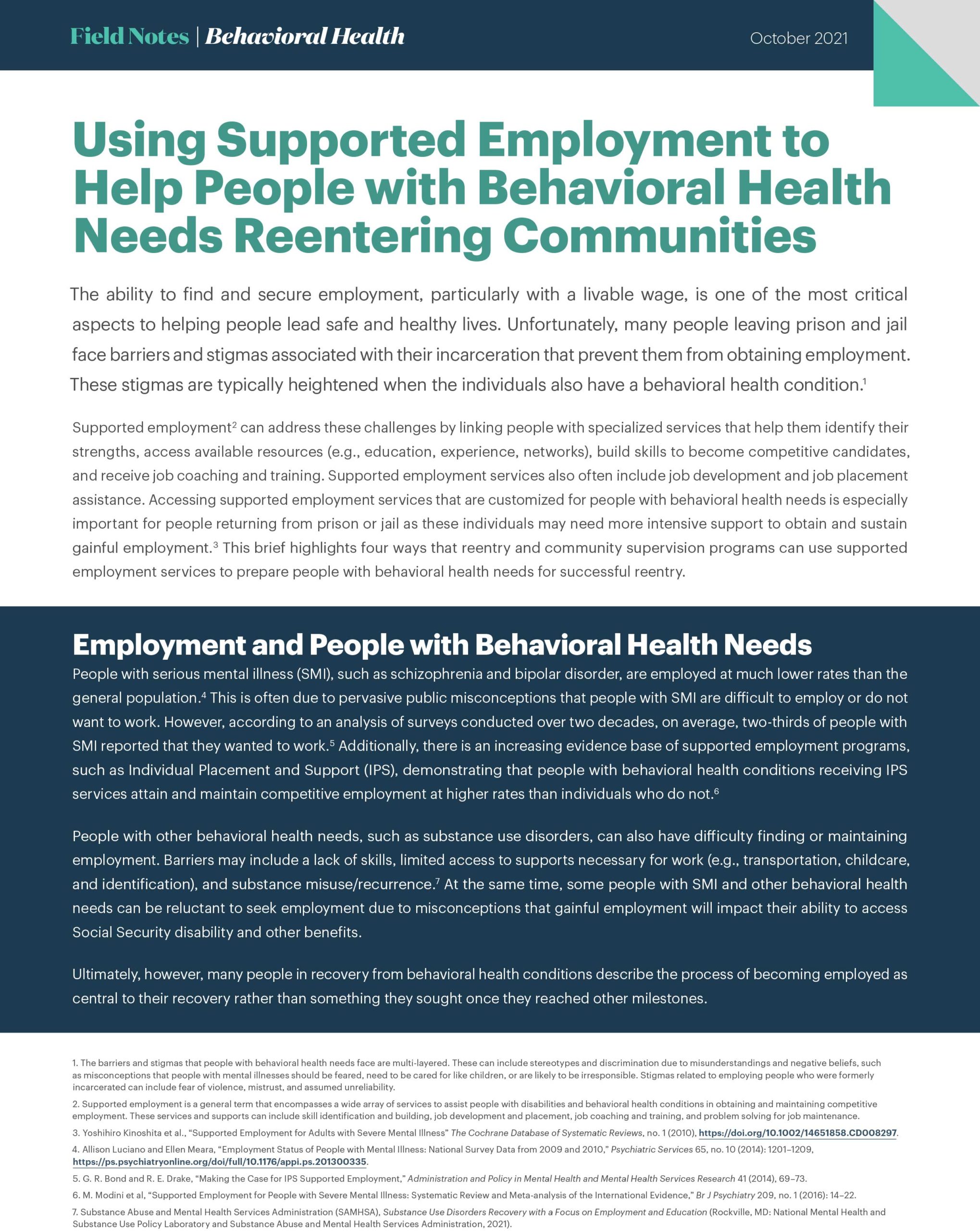Using Supported Employment to Help People with Behavioral Health Needs Reentering Communities
The ability to find and secure employment, particularly with a livable wage, is one of the most critical aspects to helping people lead safe and healthy lives. Unfortunately, many people leaving prison and jail face barriers and stigmas associated with their incarceration that prevent them from obtaining employment. Supported employment services, customized for people with behavioral health needs, can help address these challenges and provide the assistance needed for people with behavioral health conditions to obtain and sustain gainful employment as they reenter communities. This brief highlights four ways that reentry and community supervision programs can use supported employment services to prepare people with behavioral health needs for successful reentry. Photo credit: Christina @ wocintechchat.com
Using Supported Employment to Help People with Behavioral Health Needs Reentering Communities
The ability to find and secure employment, particularly with a livable wage, is one of the most critical aspects to helping people lead safe and healthy lives. Unfortunately, many people leaving prison and jail face barriers and stigmas associated with their incarceration that prevent them from obtaining employment. These stigmas are typically heightened when the individuals also have a behavioral health condition.1 Supported employment2 can address these challenges by linking people with specialized services that help them identify their strengths, access available resources (e.g., education, experience, networks), build skills to become competitive candidates, and receive job coaching and training.
Supported employment services also often include job development and job placement assistance. Accessing supported employment services that are customized for people with behavioral health needs is especially important for people returning from prison or jail as these individuals may need more intensive support to obtain and sustain gainful employment.3 This brief highlights four ways that reentry and community supervision programs can use supported employment services to prepare people with behavioral health needs for successful reentry.
Employment and People with Behavioral Health Needs
People with serious mental illness (SMI), such as schizophrenia and bipolar disorder, are employed at much lower rates than the general population.4 This is often due to pervasive public misconceptions that people with SMI are difficult to employ or do not want to work. However, according to an analysis of surveys conducted over two decades, on average, two-thirds of people with SMI reported that they wanted to work.5 Additionally, there is an increasing evidence base of supported employment programs, such as Individual Placement and Support (IPS), demonstrating that people with behavioral health conditions receiving IPS services attain and maintain competitive employment at higher rates than individuals who do not.6
People with other behavioral health needs, such as substance use disorders, can also have difficulty finding or maintaining employment. Barriers may include a lack of skills, limited access to supports necessary for work (e.g., transportation, childcare, and identification), and substance misuse/recurrence.7 At the same time, some people with SMI and other behavioral health needs can be reluctant to seek employment due to misconceptions that gainful employment will impact their ability to access Social Security disability and other benefits.
Ultimately, however, many people in recovery from behavioral health conditions describe the process of becoming employed as central to their recovery rather than something they sought once they reached other milestones.
Incorporating Supported Employment Services into Reentry Planning
Reentry and community supervision staff are tasked with preparing people leaving jail or prison for successful community integration and stable living. This can involve coordinating with a variety of stakeholders to develop case plans for individuals and linking them to needed services. For people with behavioral health needs, these staff may also be tasked with connecting them to treatment and wraparound supports. Since securing employment for someone is not often a direct service that these staff can provide, it is sometimes deprioritized or viewed as less important than other reentry services. However, research shows that employment, among other stabilizing factors, reduces recidivism.8 Below are four ways that reentry and community supervision staff can begin to incorporate supported employment services into their reentry planning or refer people to programs that are already doing the work.
1 Build connections with local supported employment providers.
Supported employment is a specialized and time intensive service. When reentry providers are unable to add this specialty to their teams, identifying referral partners is key. Local providers can be identified by searching the local Department of Vocational or Rehabilitation Services database, the Veterans Health Administration, the state mental health agency, and through the Social Security Administration’s Ticket to Work program.
2 Encourage work with ongoing conversations about employment.
Starting conversations about work can be intimidating. Knowing what questions to ask people with behavioral health conditions and how to respond in different situations are key skills for case workers and counselors. The SOAR Employment Conversation Guide9 and Sample Reponses can help case workers begin those tough, but important conversations. By initiating early conversations about work with people in prison or jail, staff can help clients identify work goals and ensure people with behavioral health conditions are receiving accurate information about supported employment and returning to work. The guide can also be used to help facilitate connections to a supported employment agency.
3 Educate clients on ways to access Social Security disability benefits and obtain employment.
People with SMI earn, on average, a third less than the median income.10 These reduced earnings underscore the importance for people with behavioral health needs to maximize their income through benefits acquisition and competitive employment. Benefits planning is essential, especially as people are preparing for reentry, and encourages people to maximize their income by applying for benefits while also working at a level that supports their needs. The Social Security Administration (SSA) funds local service providers to support in this navigation. The Ticket to Work website provides information on local providers to which case managers can refer participants. SSA’s work incentive programs are designed to help people retain their benefits while returning to work. Potential decreases in mainstream benefits are often offset by increases in earned income as well as other important outcomes like social connection and self-esteem.
4 Include employment goals and progress in regular check-ins.
Discuss the status of employment goals during regular check-in meetings. Proactive questions can help maintain momentum or address barriers to prevent job loss. Questions to ask include: Has the individual taken steps needed to obtain a job? Do they need additional supports? If they are working, how is the job going?
Dig Deeper
The Council of State Governments Justice Center offers free in-depth subject matter expertise and can answer questions about using supportive employment services to help people with behavioral health needs reentering the community. Visit the Center for Justice and Mental Health Partnerships to learn more.
Additional Resources
• The Department of Labor Career One Stop has job search resources for people with a criminal record.
• The Association of Persons in Supported Employment (APSE) provides resources for organizations.
• Individual Placement and Support is an evidenced-based practice for implementing supported employment for people with serious mental illness.
Footnotes
1 The barriers and stigmas that people with behavioral health needs face are multi-layered. These can include stereotypes and discrimination due to misunderstandings and negative beliefs, such as misconceptions that people with mental illnesses should be feared, need to be cared for like children, or are likely to be irresponsible. Stigmas related to employing people who were formerly incarcerated can include fear of violence, mistrust, and assumed unreliability.
2 Supported employment is a general term that encompasses a wide array of services to assist people with disabilities and behavioral health conditions in obtaining and maintaining competitive employment. These services and supports can include skill identification and building, job development and placement, job coaching and training, and problem solving for job maintenance.
3 Yoshihiro Kinoshita et al., “Supported Employment for Adults with Severe Mental Illness” The Cochrane Database of Systematic Reviews, no. 1 (2010), https://doi.org/10.1002/14651858.CD008297.
4 Allison Luciano and Ellen Meara, “Employment Status of People with Mental Illness: National Survey Data from 2009 and 2010,” Psychiatric Services 65, no. 10 (2014): 1201–1209, https://ps.psychiatryonline.org/doi/full/10.1176/appi.ps.201300335.
5 G. R. Bond and R. E. Drake, “Making the Case for IPS Supported Employment,” Administration and Policy in Mental Health and Mental Health Services Research 41 (2014), 69–73.
6 M. Modini et al, “Supported Employment for People with Severe Mental Illness: Systematic Review and Meta-analysis of the International Evidence,” Br J Psychiatry 209, no. 1 (2016): 14–22.
7 Substance Abuse and Mental Health Services Administration (SAMHSA), Substance Use Disorders Recovery with a Focus on Employment and Education (Rockville, MD: National Mental Health and Substance Use Policy Laboratory and Substance Abuse and Mental Health Services Administration, 2021).
8 Joe Graffam et al., “Variables Affecting Successful Reintegration as Perceived by Offenders and Professionals,” Journal of Offender Rehabilitation 40, no.1-2 (2004): 47–171.
9 SAMHSA’s Supplemental Security Income (SSI)/ Social Security Disability Insurance (SSDI) Outreach, Access, and Recovery (SOAR) program increases access to Social Security disability benefits for eligible individuals with SMI and co-occurring substance use disorders. Implementation of SOAR has proven to be successful in reentry settings. See SAMHSA, SOAR Works for Individuals Involved in the Criminal Justice System (Rockville, MD: 2019), https://soarworks.samhsa.gov/sites/soarworks.prainc.com/files/CJBestPractices-508-Final_0.pdf.
10 D. Levinson et al., “Associations of Serious Mental Illness with Earnings: Results from the WHO World Mental Health Surveys,” Br J Psychiatry 197, no. 2 (2010):114–21.
Project Credits
Writing: Kristin Lupfer, Policy Research Associates
Research: Kristin Lupfer, Policy Research Associates
Advising: Demetrius Thomas, CSG Justice Center
Editing: Darby Baham, Emily Morgan, Leslie Griffin, CSG Justice Center
Design: Michael Bierman
Public Affairs: Ruvi Lopez, CSG Justice Center
Web Development: Eleventy Group
This project was supported by Grant No. 2019-MO-BX-K001 awarded by the Bureau of Justice Assistance. The Bureau of Justice Assistance is a component of the Department of Justice’s Office of Justice Programs, which also includes the Bureau of Justice Statistics, the National Institute of Justice, the Office of Juvenile Justice and Delinquency Prevention, the Office for Victims of Crime, and the SMART Office. Points of view or opinions in this document are those of the author and do not necessarily represent the official position or policies of the U.S. Department of Justice.
About the Author
The sharp rise in school shootings over the past 25 years has led school officials across the U.S.…
Read MoreA three-digit crisis line, 988, launched two years ago to supplement—not necessarily replace—911. Calling 988 simplifies access to…
Read More Taking the HEAT Out of Campus Crises: A Proactive Approach to College Safety
Taking the HEAT Out of Campus Crises: A Proactive Approach to College Safety
The sharp rise in school shootings over the past 25 years has…
Read More From 911 to 988: Salt Lake City’s Innovative Dispatch Diversion Program Gives More Crisis Options
From 911 to 988: Salt Lake City’s Innovative Dispatch Diversion Program Gives More Crisis Options
A three-digit crisis line, 988, launched two years ago to supplement—not necessarily…
Read More Matching Care to Need: 5 Facts on How to Improve Behavioral Health Crisis Response
Matching Care to Need: 5 Facts on How to Improve Behavioral Health Crisis Response
It would hardly be controversial to expect an ambulance to arrive if…
Read More











